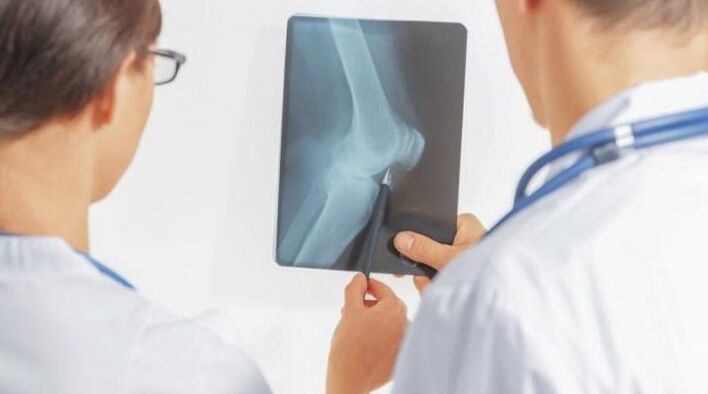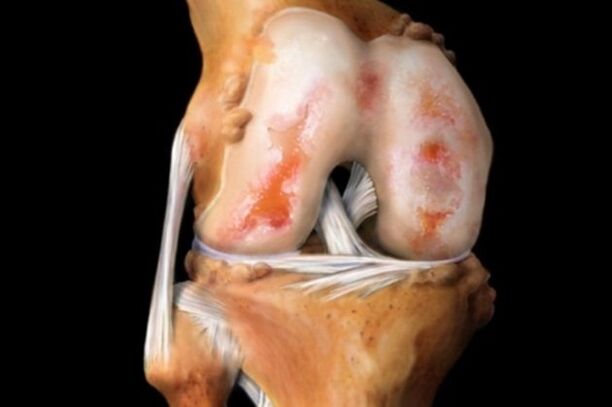
Regular knee pain during movement and limited mobility indicate a serious problem with the joint. With a high degree of probability, arthrosis will be diagnosed - the rupture of the cartilaginous tissue of the joint. To avoid disability, it will be necessary to treat arthrosis of the knee joint.
What medications are prescribed to treat joint osteoarthritis?
The choice of the appropriate treatment system and medications depends on the degree of joint damage and the presence of concomitant diseases. If arthrosis is in the 1st or 2nd stage, drug treatment is possible. In the case of the 3rd stage of the disease, complicated by other illnesses, the only treatment is surgery. Therefore, it is important to recognize the problem in time and start solving it with conservative methods.
Osteoarthritis can develop in childhood due to inadequate formation of ligaments or joint surfaces.

The disease can also appear after injury or the formation of other pathologies in the body, including:
- fractures, muscle strains, bruises and knee dislocations;
- consequences of professional sport;
- meniscus surgery;
- arthritis;
- obesity;
- salt deposits in the joint;
- pathologies that are accompanied by muscle spasms.
If the treatment of arthrosis of the knee joint is started immediately after identifying the first signs of the disease, a complete recovery is possible. At a later stage, when the disease becomes chronic, long-term remission can be achieved.
Classic treatments include:
- use of medications;
- manual therapy, exercise therapy, physiotherapy and massage;
- use of traditional medicine (ointments, rubs).
Today, doctors offer new methods of treating arthrosis of the knee joint: the use of drugs containing hormones, drugs to relieve spasms and restore the cartilaginous tissue of the joint. These are non-steroidal medications that relieve inflammation, chondroprotectors, various types of ointments, compresses, intra-articular injections.
Complex treatment of arthrosis of the knee joint is also possible, in which the use of traditional medicine, medications and massage at the same time is allowed. They complement each other's actions, relieve pain and promote joint renewal.
Let's see how each type of medication works in the treatment of osteoarthritis.

General information
In the process of restoring the joint, you should limit the load on the knee and adhere to the orthopedic regimen. During an exacerbation, the patient's nutrition plays an important role.
All efforts in the treatment phase should be aimed at:
- pain relief;
- elimination of inflammation and swelling;
- improving the condition of articular cartilage;
- activation of the blood supply to the sore knee;
- restoration of articular muscles.
Nonsteroidal anti-inflammatory drugs
The treatment regimen for knee osteoarthritis usually includes therapy with nonsteroidal anti-inflammatory drugs (NSAIDs). They reduce pain and eliminate inflammation. Prescribing medication in the form of injections is more effective. The medicines act quickly on the affected area and do not affect the functioning of the gastrointestinal tract. NSAIDs are sometimes used in the form of ointments. They are less effective and generally serve as a complement to the main treatment.
The treating physician usually prescribes nonsteroidal medications in the lowest effective doses, increasing them if necessary.

Chondroprotectors
In addition to NSAIDs, to improve the condition of the sore knee, chondroprotectors are prescribed, which restore cartilaginous tissue and improve the composition of synovial fluid. A special feature of this group of drugs is the long recovery period during administration of the drugs. The course of treatment of arthrosis of the knee joint with chondroprotectors lasts six months or more. If no visible changes occur during this period, other recovery methods will be selected.
It is advisable to simultaneously use chondroprotectors and hyaluronic acid. Preparations based on hyaluronic acid are injected into the joint. They promote the restoration of connective tissues, as they participate in the formation of chondrocytes - articular cartilage cells.
Ointments for knee treatment
For arthrosis, it is also recommended to use local medicines, for example, ointments. They cannot completely cope with the disease, so they are used in conjunction with other medicines. The use of ointments can speed healing.
The main effects of ointments for arthrosis:
- relieve inflammation;
- eliminate pain;
- relieve muscle spasms;
- improve blood circulation;
- heat up;
- improve the nutrition of joint tissues;
- protect against the development of infection.
Compresses for knee osteoarthritis
This type of manipulation is the most common in the treatment of gonarthrosis and osteoarthritis. This is due to the rather rapid relief of the symptoms of the disease. Compresses are most often used in alternative medicine, where herbal decoctions and tinctures are used for treatment. It should be understood that the compress does not cure the disease by itself, therefore it is necessary to combine its use with taking traditional medicines.
The use of compresses is associated with quickly obtaining positive effects:
- blood circulation improves;
- nutrients and components of the medicine quickly reach the affected area of the joint;
- muscle tone increases;
- inflammation is relieved;
- pain intensity decreases;
- the functionality of synovial fluid is restored.
Intra-articular injections
Intra-articular injection is one of the most advanced forms of treatment. This therapy is highly effective, but also quite expensive. The condition of the sore knee improves due to the fact that the medicine directly reaches the affected area. The drug stops the development of the inflammatory process and provides nutrition to the articular cartilage. Intra-articular injections of chondroprotectors treat the joint and do not just relieve symptoms.

If the medicine is injected directly into the joint capsule area, it immediately begins to act. With intramuscular, intravenous injections and taking tablets, the onset of action is significantly prolonged. Additionally, there are negative side effects on other organs.
There are two groups of medications prescribed for joint injections. These include glucocorticoids and hyaluronic acid.
Vitamin complex
Vitamins are an important complement to medications and other treatments. They promote the rapid renewal of cartilage tissue and also maintain the general condition of the body. In the treatment of arthrosis, vitamins B, C, A and E are prescribed in parallel with medications.
Manual therapy in the treatment of gonarthrosis
Comprehensive therapy for arthrosis should include manual therapy procedures. The specialist uses his hands on the patient's body to improve blood circulation in the affected joint, normalize its mobility and prevent atrophic processes. Manual exercises, when combined with medications, help in the treatment of osteoarthritis of the knee and hip joints.
The duration of using manual therapy procedures depends on the severity of osteoarthritis. Typically, the doctor prescribes 1 to 10 sessions. This method is effective in the initial or intermediate stages of the disease. The degree of damage, treatment methods and duration of use of each method should be prescribed by an orthopedist after a complete diagnosis.

Physiotherapy for gonarthrosis
This method of joint treatment is very effective in combination with medications. Physiotherapy can speed up the recovery process, reduce doses of medications taken and the likelihood of side effects.
There are several types of physical therapy used for osteoarthritis:
- exposure to a magnetic field;
- electrophoresis;
- radiation exposure;
- ultrasonic influence.
The type of physiotherapy, its duration and quantity are prescribed by the physiotherapist after the patient has been diagnosed. There are several concomitant diseases for which physiotherapy is contraindicated.
Physiotherapy
Special exercises for arthrosis are used in the initial stages of the disease, when the cartilaginous tissue has not yet been destroyed. Moderate physical activity can prevent negative changes in joints. At a later stage of arthrosis, physical education for therapeutic purposes is used during the period of remission, when primary therapy is carried out to relieve pain and inflammation.

All exercises should be performed smoothly with moderate load on the legs. A properly selected complex of therapeutic exercises improves blood circulation, increases metabolism and activates the absorption of medications, strengthens muscles, which guarantees effective treatment of arthrosis of the knee joint.
Physiotherapy exercises are included in the treatment of rheumatoid osteoarthritis.
Surgery
Advanced-stage osteoarthritis cannot be treated with medication. The only solution is surgery. Only she can restore knee mobility. The factors for prescribing surgical treatment are the third stage of arthrosis, the lack of effect of conservative methods and severe knee injuries against the background of the development of arthrosis.
Today, there are four types of surgical intervention to treat knee pain:
- joint preservation;
- joint replacement;
- joint resection;
- strengthening joints.
The type of operation is selected by the doctor based on the degree of damage to the joint, concomitant diseases and the patient's body's response to the use of a particular method of conservative treatment. It should be understood that surgical intervention is accompanied by a long period of rehabilitation using a therapeutic complex. Therefore, the need for surgery must be strictly justified by a comprehensive diagnosis.
Diet
Proper nutrition during the development of osteoarthritis can reduce the rate of joint damage and increase the effectiveness of treating the disease. It is important to understand which foods should be present in the diet regularly and which ones should be abandoned forever. Sea fish, fresh vegetables and fruits help improve joint function. Fish oil improves the condition of cartilage. Furthermore, phosphorus, iron and selenium are important in the formation of many tissues, including cartilage. Apple and pomegranate juice have good anti-inflammatory properties. Its presence in the diet not only prevents the development of inflammatory processes, but also combats those that have already started.
People suffering from osteoarthritis need to exclude foods containing trans fats from their diet. Additionally, you should avoid fatty meats, whole milk and corn oil. The fats contained in these products destroy the cartilage tissue of the joints.



















